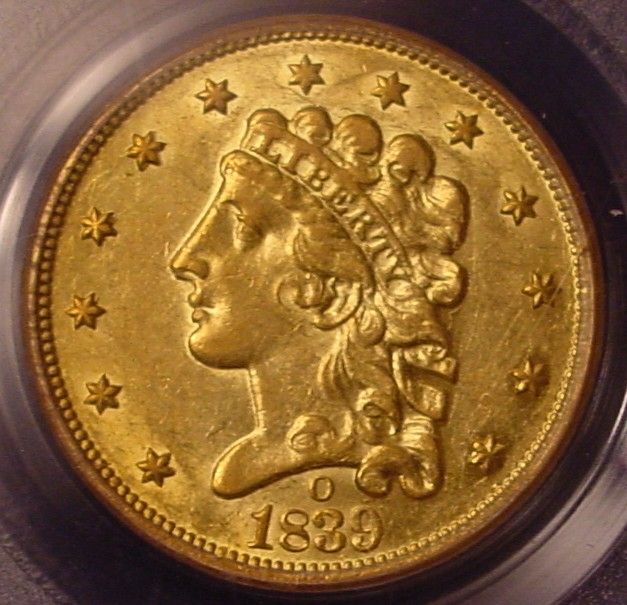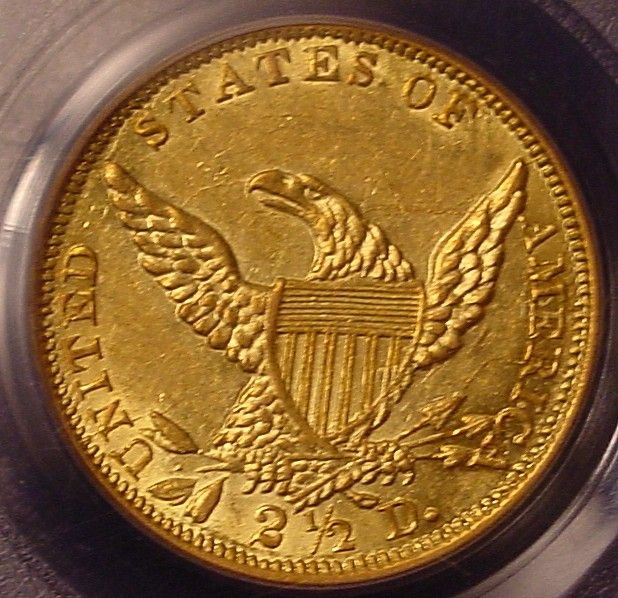An 1839-O $2.50 gold piece


The 1839-O is a historically important issue. This was the first gold coin to be issued by the New Orleans Mint, and it was the only Classic Head $2.50 the O-Mint produced. It is also the only New Orleans mint quarter eagle that has the mint mark on the obverse.
Although this coin has a slightly lower mintage than the 1839-C quarter eagle (17,781 vs. 18,140) it is more common because a larger than normal number of pieces were saved as the first of their kind. This is probably a reflection of the greater affluence that residences of the New Orleans area enjoyed over those who lived in the southern gold fields. Although the coin is not terribly scarce, strictly Mint State examples are very scarce, and AU-58 examples such this piece are not common.
The coin pictured above is a very sharp example of this historic coin with a great deal of mint luster. PCGS graded it AU-58, and it has a CAC sticker. It is the Winter variety #2 ("9" in the date well away from the curl and even with the "3" / the "3" shows recutting on the inside curl / the berry on the reverse is detached from stem / arrow heads are malformed) The dies are also rotated 180 degrees to the "medal turn," which has been noted for this variety. It is believed that this is the scarcer of the two varieties, although other experts believe that this is the more common variety.
I believe that this coin was made from the first die pair that was used to strike these coins at the New Orleans Mint. I base this on the fact that the reverse die is completely rotated the medal turn. My theory is that inexperienced mint personnel mounted the die incorrectly in the coin press. They also did a less than perfect job of preparing (basining) the dies for use as indicated by the missing design elements on the reverse. If there is further interest I will get into a commentary about branch mint die preparation in the 19th century.
This marks my last summer FUN show purchase. I spotted this coin at the show, but hesitated to buy it because I had spent most of my budget. After I got home I decided that is was an opportunity and that I go ahead and purchase it, so here it is.
Retired dealer and avid collector of U.S. type coins, 19th century presidential campaign medalets and selected medals. In recent years I have been working on a set of British coins - at least one coin from each king or queen who issued pieces that are collectible. I am also collecting at least one coin for each Roman emperor from Julius Caesar to ... ?
0
Comments
The 1839 quarter eagles from all four mints make an interesting small set. One which represents the beginnings of one of the most interesting periods of numismatics, the 1839-1861 era where the three southern branch mints were in operation. The inclusion of the obverse mint mark only adds to the interest of this set.
<< <i> If there is further interest I will get into a commentary about branch mint die preparation in the 19th century. >>
I'm interested!
Latin American Collection
Collector since 1976. On the CU forums here since 2001.
Sunnywood
Sunnywood's Rainbow-Toned Morgans (Retired)
Sunnywood's Barber Quarters (Retired)
<< <i>Nice coin Bill.
The 1839 quarter eagles from all four mints make an interesting small set. One which represents the beginnings of one of the most interesting periods of numismatics, the 1839-1861 era where the three southern branch mints were in operation. The inclusion of the obverse mint mark only adds to the interest of this set.
<< <i> If there is further interest I will get into a commentary about branch mint die preparation in the 19th century. >>
I'm interested! >>
All of the dies that were used at Charlotte, Dahlonega and New Orleans were made at the Philadelphia Mint and shipped south. The dies were not in a completed state and ready for use, however. The theory was that if the dies happened to fall into the wrong hands, would be counterfeiters would be unable to make bogus coins with them.
What remained to be done was that the dies had to be basined which involved contouring the fields so that the correct metal flow would occur when they were used to strike the coins. Following this procedure the dies were hardened by heating them to a red hot temperature than quickly cooled or quenched by plunging them in water or oil.
The personnel at the New Orleans mint learned how to perform the required die preparation steps fairly well. That was reflected by the quality of their coins. And yes collectors are aware of a number of dates of O-Mint Morgan dollars that were made from poorly prepared dies, but those coins were made during a much later era in the 1890s and early 1900s. During the antebellum period, the New Orleans mint generally produced high quality coins.
The same could not be said for the Charlotte and Dahlonega Mints. Charlotte in particular had a lot of issues with preparing the dies for coinage, and it showed in the quality of their products. Dahlonega did bit better, but some of their coins were also subpar.
Two other factors contributed to the lower quality of southern mint coins. First, it was alleged by some southern mint personnel that the head office sent some of their poorly quality dies south, and kept the best dies for the Philadelphia mint operations. There was probably some truth to these allegations. Second the southern dies often arrived with some rust on them, which certainly would have improved the finished product.
Here are a couple of southern mint coins that reflected their crude methods of die preparation.
This 1849-D gold dollar was made from dies that had excessively convex fields.
And the 1855-C gold dollar is notorious for the wretched quality of the issue. Although this coin is not overly rare with a mintage of 9,803, the finest known examples grade no better than MS-61 because of the overall poor quality of the coins.
Joseph J. Singleton - First Superintendent of the U.S. Branch Mint in Dahlonega Georgia
Findley Ridge Collection
About Findley Ridge
New collectors, please educate yourself before spending money on coins; there are people who believe that using numismatic knowledge to rip the naïve is what this hobby is all about.
Very, Very Nice Quarter Eagle
Great history info on the Southern Mints...Thank you.
the info and the pictures of some SUPER coins!!
I'm inferring that you think that this die pair was more improperly basined as compared to the Wide Fraction reverse, and would like to hear more of your reasoning. I've done some research and I found that the Wide Fraction reverse, generally, shows less detail than the Close Fraction reverse. I think it was from a combination of the Wide Fraction reverse die cracking early on (though both reverses cracked) and from excessive die polishing, especially on the lower portion.
Here are some pics showing both reverses, the Wide Fraction and Close Fraction. The Wide Fraction shows weakness in the berry stem, the stem over the D, and the arrows. I believe that the Wide Fraction reverse shown is a great strike.
I give away money. I collect money.
I don’t love money . I do love the Lord God.
Love this board!
Dave
I would say that both the wide and narrow fraction varieties show evidence of excessive die polishing. Design elements, like a berry, should not be hanging in mid air! As for the basining question, Roger Burdette, who posts ATS claims that all of it was done at the Philadelphia mint during this period, and that Philly shipped the dies to the branch mints in a "ready to go" status, fully hardened.
To me the cincher that makes the close fraction the variety the first die used for the 1839-O quarter eagles is the fact that the die was mounted upside-down. It did not rotate to the position during use, but was positioned in the coin press from the start. Clearing the New Orleans Mint guys were no quite ready to be prime time players at this early stage.